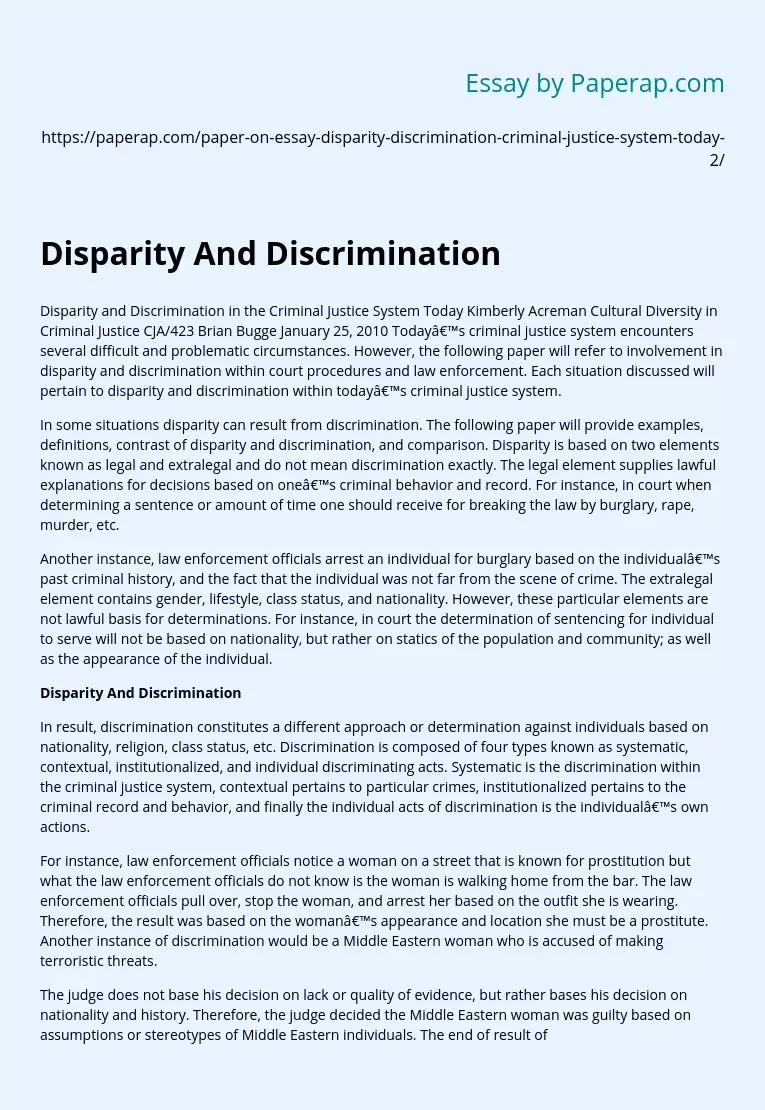Disparity And Discrimination
Disparity and Discrimination in the Criminal Justice System Today Kimberly Acreman Cultural Diversity in Criminal Justice CJA/423 Brian Bugge January 25, 2010 Today’s criminal justice system encounters several difficult and problematic circumstances. However, the following paper will refer to involvement in disparity and discrimination within court procedures and law enforcement. Each situation discussed will pertain to disparity and discrimination within today’s criminal justice system.
In some situations disparity can result from discrimination. The following paper will provide examples, definitions, contrast of disparity and discrimination, and comparison.
Disparity is based on two elements known as legal and extralegal and do not mean discrimination exactly. The legal element supplies lawful explanations for decisions based on one’s criminal behavior and record. For instance, in court when determining a sentence or amount of time one should receive for breaking the law by burglary, rape, murder, etc.
Another instance, law enforcement officials arrest an individual for burglary based on the individual’s past criminal history, and the fact that the individual was not far from the scene of crime.
The extralegal element contains gender, lifestyle, class status, and nationality. However, these particular elements are not lawful basis for determinations. For instance, in court the determination of sentencing for individual to serve will not be based on nationality, but rather on statics of the population and community; as well as the appearance of the individual.
Disparity And Discrimination
In result, discrimination constitutes a different approach or determination against individuals based on nationality, religion, class status, etc.
Discrimination is composed of four types known as systematic, contextual, institutionalized, and individual discriminating acts. Systematic is the discrimination within the criminal justice system, contextual pertains to particular crimes, institutionalized pertains to the criminal record and behavior, and finally the individual acts of discrimination is the individual’s own actions.
For instance, law enforcement officials notice a woman on a street that is known for prostitution but what the law enforcement officials do not know is the woman is walking home from the bar. The law enforcement officials pull over, stop the woman, and arrest her based on the outfit she is wearing. Therefore, the result was based on the woman’s appearance and location she must be a prostitute. Another instance of discrimination would be a Middle Eastern woman who is accused of making terroristic threats.
The judge does not base his decision on lack or quality of evidence, but rather bases his decision on nationality and history. Therefore, the judge decided the Middle Eastern woman was guilty based on assumptions or stereotypes of Middle Eastern individuals. The end of result of the judge’s determination led to people on the outside looking in and wondering if we as a country have any unity among individuals of different nationalities. Therefore, when comparing disparity and discrimination they are alike because they both focus on sentencing an individual for a crime committed either in court or by arrest.
Both disparity and discrimination assist in determining on whether or not an individual is guilty or an assumption that an individual is guilty. When contrasting disparity and discrimination an individual is sentenced on a separate scale that is typically harsher. Discrimination separates into several difficult situations that compare to disparity, but are limited in the area. Discrimination can be possible and yet ending in results. However, they are not the same. Therefore, we can decrease the chance of discrimination by making sure that all laws are applied equally to all individuals who break them.
If an African American is arrested and charged for a drug offense, and it is their first offense then the individual should receive the same sentence determination as any other individual with regard to their personal criminal history and the seriousness of the crime. What many people ponder about is how can just as many white people deal drugs as African Americans, but yet they receive unequal and unfair punishments with one another. Therefore, constant and consistent punishments are crucial to decline disparity and maybe even deduct the belief that our system discriminates.
The biggest obstacle will be to make sure that all local and state departments come together to reach a solution that everyone can agree with. This is the biggest obstacle because every area from rural to urban to city have their own crimes that they are tougher and more lenient on. However, it is these particular inconsistencies that fault our system and makes people whole heartedly believe that our system discriminates (2006, Rivera). In closing, discriminating situations do happen within our justice system, and it is crucial for our system that reform is developed.
Without some come of reform that focuses on racial disparities within our system the next generation of prisoners will be created. Therefore, reform is crucial to cease any disparities and discrimination within our system to resolve the particular issues pertaining to disparity and discrimination.
Reference Rivera, B (2006, March 15) Disparity verses Discrimination in the Justice System. Retrieved January 23, 2010 from:
Disparity And Discrimination. (2019, Dec 05). Retrieved from https://paperap.com/paper-on-essay-disparity-discrimination-criminal-justice-system-today-2/

